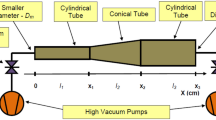Abstract
The effusion of gas through a small rectangular opening into a vacuum is studied using methods of mathematical modeling. The distribution functions of gas particles flowing out of an opening and the moments of these functions, i.e., fields of gas particle concentrations and velocities, are obtained. The dependence of effusion on the volume from which the gas escapes is investigated.











Similar content being viewed by others
REFERENCES
Ponomareva, V.L., Kosmonavtika v lichnom izmerenii (Cosmonautics in the Personal Dimension), Moscow: Kosmoskop, 2016.
Kubarev, Yu.V., Flights to Mars, electric propulsion engines of the present and future, Nauka Tekhnol. Prom-sti, 2006, no. 2, p. 19.
Dushman, S. and Lafferty, J.M.,Scientific Foundations of Vacuum Technique, New York: Wiley, 1962.
Saksaganskii, G.L., Molekulyarnye potoki v slozhnykh vakuumnykh strukturakh (Molecular Flows in Complex Vacuum Structures), Moscow: Atomizdat, 1980.
Anan’in, A.A., Zanin, A.N., and Semkin, N.D., Modeling of gas leakage from a spacecraft module, Izmerit. Tekh., 2001, no. 4, p. 29.
Zanin, A.N., Device for recording the place of air leakage from the module of the space station, Cand. Sci. (Tech. Sci.) Dissertation, Samara: Samara State Aerospace Univ., 2009.
Nesterov, S.B., Vasil’ev, Yu.I., and Androsov, A.V., Raschet slozhnykh vakuumnykh sistem (Calculation of Complex Vacuum Systems), Moscow: MEI, 2001.
Nesterov, S.B., Astashina, M.A., Neznamova, L.O., and Vasil’ev, Yu.K., Tasks and methods for studying a rarefied gas medium near a spacecraft, Vakuum. Tekh. Tekhnol., 2007, vol. 18, no. 3, p. 183.
Astashina, M.A., Molecular flows in complex objects taking into account gas evolution of surfaces, Cand. Sci. (Tech. Sci.) Dissertation, Moscow: Mosc. Power Eng. Inst., 2009.
Rozanov, L.N. and Skryabnev, A.Yu., Gas flow through a round pipe at large pressure drops, Vakuum. Tekh. Tekhnol., 2010, vol. 20, no. 1, p. 3.
Skryabnev, A.Yu., Vacuum measuring method for monitoring the tightness of large technical objects, Cand. Sci. (Tech. Sci.) Dissertation, St. Petersburg: SPb. State Polytech. Univ., 2012.
Tang, M.J., Cox, R.A., Kalberer, M., Compilation and evaluation of gas phase diffusion coefficients ofreactive trace gases in the atmosphere: Vol. 1. Inorganic compounds, Atmos. Chem. Phys., 2014, no. 14, p. 9233.
Krewinkel, R., A review of gas turbine effusion cooling studies, Int. J. Heat Mass Transfer, 2013, vol. 66, p. 706.
Schumacher, J.C., Zupanc, F.J., and Dudebout, R., Segmented effusion cooled gas turbine engine combustor, US Patent no. 7546737B2, 2006.
Wahlbeck, P.G., Effusion. VII. The failure of isotropy of a gas in an effusion cell and the transition region, J. Chem. Phys., 2003, vol. 55, no. 1709 (1971).
Malhotra, M. and Kumar, S., Thermal gas effusion from diamond-like carbon films, Diamond Relat. Mater., 1997, vol. 6, no. 12, p. 1830.
Bronson, T.J., Zupanc, F.J., Yankowich, P., Rudrapatna, N., Effusion cooled dual wall gas turbine combustors, US Patent US9897320B2, 2010.
Iczkowski, R.P., Margrave, J.L., and Robinson, S.M., Effusion of gases through conical orifices, J. Phys. Chem., 1963, no. 67, no. 2, p. 229.
Kotel’nikov, V.A., Ul’danov, S.V., and Kotel’nikov, M.V., Protsessy perenosa v pristenochnykh sloyakh plazmy (Transfer Processes in the Parietal Layers of Plasma), Moscow: Nauka, 2004.
Kotel’nikov, V.A., Kotel’nikov, M.V., and Gidaspov, V.Yu., Matematicheskoe modelirovanie obtekaniya tel potokami stolknovitel’noi i besstolknovitel’noi plazmy (Mathematical Modeling of Bodies Flowing in Collisional and Collisionless Plasma Flows), Moscow: Fizmatlit, 2010.
Kotel’nikov, M.V., Kotel’nikov, V.A., and Morozov, A.V., Matematicheskoe modelirovanie vzaimodeistviya potoka razrezhennoi plazmy s poperechnym magnitnym polem (Mathematical Modeling of the Interaction of a Rarefied Plasma Flow with a Transverse Magnetic Field), Moscow: MAI, 2015.
Kotel’nikov, V.A., Gurina, T.A., Demkov, V.P., and Popov, G.A., Matematicheskoe modelirovanie elektrodinamiki letatel’nogo apparata v razrezhennoi plazme (Mathematical Modeling of the Electrodynamics of an Aircraft in a Rarefied Plasma), Moscow: Nats. Akad. Prikl. Nauk RF, 1999.
Kotel’nikov, M.V. and Kotel’nikov, V.A., An advanced method of characteristics, Mat. Model., 2017, vol. 29, no. 5, p. 85.
Kotel’nikov, M.V. and Nguen, S.Tk., The technique of using computer graphics in computational experiments, Tr. MAI, 2011, no. 53.
Savel’ev, I.V., Kurs fiziki (Course of Physics), Moscow: Nauka, 1989, Vol. 1.
Author information
Authors and Affiliations
Corresponding authors
Ethics declarations
The authors declare they have no conflict of interest.
Additional information
Translated by L. Trubitsyna
About this article
Cite this article
Kotelnikov, V.A., Kotelnikov, M.V., Filippov, G.S. et al. Mathematical Modeling of Gas Effusion into a Vacuum. J. Mach. Manuf. Reliab. 49, 197–205 (2020). https://doi.org/10.3103/S1052618820030061
Received:
Accepted:
Published:
Issue Date:
DOI: https://doi.org/10.3103/S1052618820030061




